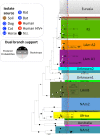Worldwide Phylogenetic Distributions and Population Dynamics of the Genus Histoplasma
- PMID: 27248851
- PMCID: PMC4889077
- DOI: 10.1371/journal.pntd.0004732
Worldwide Phylogenetic Distributions and Population Dynamics of the Genus Histoplasma
Abstract
Background: Histoplasma capsulatum comprises a worldwide complex of saprobiotic fungi mainly found in nitrogen/phosphate (often bird guano) enriched soils. The microconidia of Histoplasma species may be inhaled by mammalian hosts, and is followed by a rapid conversion to yeast that can persist in host tissues causing histoplasmosis, a deep pulmonary/systemic mycosis. Histoplasma capsulatum sensu lato is a complex of at least eight clades geographically distributed as follows: Australia, Netherlands, Eurasia, North American classes 1 and 2 (NAm 1 and NAm 2), Latin American groups A and B (LAm A and LAm B) and Africa. With the exception of the Eurasian cluster, those clades are considered phylogenetic species.
Methodology/principal findings: Increased Histoplasma sampling (n = 234) resulted in the revision of the phylogenetic distribution and population structure using 1,563 aligned nucleotides from four protein-coding regions. The LAm B clade appears to be divided into at least two highly supported clades, which are geographically restricted to either Colombia/Argentina or Brazil respectively. Moreover, a complex population genetic structure was identified within LAm A clade supporting multiple monophylogenetic species, which could be driven by rapid host or environmental adaptation (~0.5 MYA). We found two divergent clades, which include Latin American isolates (newly named as LAm A1 and LAm A2), harboring a cryptic cluster in association with bats.
Conclusions/significance: At least six new phylogenetic species are proposed in the Histoplasma species complex supported by different phylogenetic and population genetics methods, comprising LAm A1, LAm A2, LAm B1, LAm B2, RJ and BAC-1 phylogenetic species. The genetic isolation of Histoplasma could be a result of differential dispersion potential of naturally infected bats and other mammals. In addition, the present study guides isolate selection for future population genomics and genome wide association studies in this important pathogen complex.
Conflict of interest statement
The authors have declared that no competing interests exist.
Figures



References
-
- Menges RW, Furcolow ML, Selby LA, Habermann RT, Smith CD. Ecologic studies of histoplasmosis. American journal of epidemiology. 1967;85(1):108–19. Epub 1967/01/01. . - PubMed
-
- Lockwood GF, Garrison RG. The possibel role of uric acid in the ecology of Histoplasma capsulatum. Mycopathologia et mycologia applicata. 1968;35(3):377–88. Epub 1968/10/14. . - PubMed
-
- Negroni R. [Histoplasmosis in Latin America]. Biomedica: revista del Instituto Nacional de Salud. 2011;31(3):304 Epub 2012/08/02. . - PubMed
-
- Kwon-Chung KJ, Bennett JE. Medical Mycology. Philadelphia: Lea & Febiger; 1992.
Publication types
MeSH terms
Grants and funding
LinkOut - more resources
Full Text Sources
Other Literature Sources
Medical

